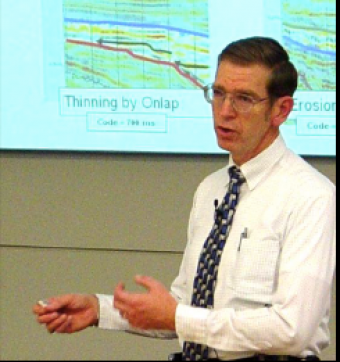This lesson focuses on the third essential element of a hydrocarbon play, seal rocks, and the major process of hydrocarbon migration. This lesson defines hydrocarbon seal rocks, which are rock units with low permeability that impede the escape of hydrocarbons from the reservoir rock, like evaporites, chalks and shales. This lesson also explores the question that if given a particular trap, how much oil or gas can it hold? The student will examine the effectiveness of a given seal rock, and a particular trap to hold hydrocarbons.
This lesson can be broken up into four (4) segments. The instructor can review material conducted in the lesson on 'Structural Analysis and Trap Formation', present the lecture information collected here, and then introduce the two (2) parts of the exercise. The review of the previous lecture information could take approximately fifteen (15) minutes, and contains thirteen (13) slides. The lecture information presented here has thirty-six (36) slides, and will take approximately forty-five (45) minutes to present. The introduction to the first part of the exercise contains seven (7) slides and will take about ten (10) minutes to explain, while the second part contains nine (9) slides and will take about twelve (12) minutes to explain.
The exercises are based on information presented in the lecture. The part A of the exercise walks the students through the construction of an Allan diagram and a consideration of a cross-fault leak point. Steps includes: 1. Get depths for the top of the reservoir along the high side of Fault A; 2. Post these depths on a grid and draw a depth profile; 3. Draw a depth profile for the base of the reservoir – high side (100 ft lower), 4. Do the same for the top/base of the reservoir on the low side of Fault A, and 5. Find the potential leak point – where the base of the reservoir on the high side coincides with the top of the reservoir on the low side. For this exercise, we assume the fault does not seal fluids, at least on a geologic time scale. This means there is enough porosity and permeability to allow fluids to communicate. The determination of whether a fault seals or leaks is an entirely different analysis, which is beyond the scope of this course.
Part B of the exercise walks the students through a series of volume calculations for three (3) traps and oil generation/migration. Three (3) different HC charges (HCs arriving at the deepest trap) are given. The students are to figure out the HC distribution within the three (3) traps for each case. Cases 1 and 2 consider the charge to be only oil. Case 3 has a charge of oil and gas. Students will: 1. Estimate the total trap volume for traps A, B, and C; 2. Work out the HC volume (capacity) of each trap; 3. Convert the volumes from cubic km to million barrels; 4. Determine the most likely oil volume reaching Trap A; 5. Distribute this most likely oil volume to the 3 traps (Case 1); 6. Reduce the oil volume to 75% and distribute this oil (Case 2); and 7. Are given the volume of oil and gas and distribute this oil and gas (Case 3).
There are two (2) main points to emphasize in the exercises:
At the end of the lesson, the student should be able to:

This course, based on teaching material from Dr. Fred Schroeder (formerly of Exxon/ExxonMobil), reflects on the geology and geophysics basics for the petroleum industry. General geology and basic geophysics are not required, but helpful with the material.
We encourage the reuse and dissemination of the material on this site as long as attribution is retained. To this end the material on this site, unless otherwise noted, is offered under Creative Commons Attribution (CC BY 4.0) license